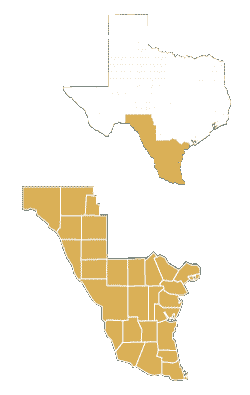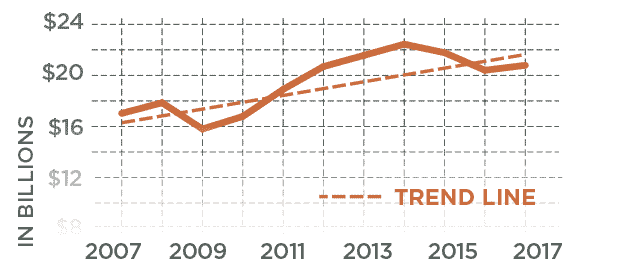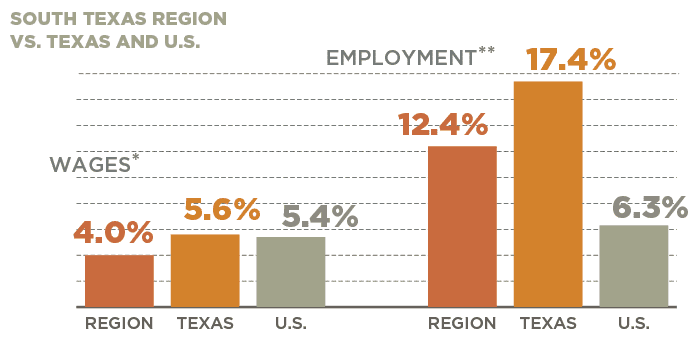Regional Snapshot
South Texas

As the state’s chief financial officer, I am charged with monitoring the economic health of our state and its regions. The state of Texas has 12 economic regions including the South Texas Region.
The 28-county South Texas Region covers about 37,800 square miles in southernmost Texas, stretching along the Mexican border from Del Rio to Brownsville and up the Gulf Coast past Rockport to Aransas Pass and San Antonio Bay. Below we examine demographic and economic statistics that influence the region’s economy.
Glenn Hegar
Texas Comptroller of Public Accounts
South Region Counties:
- Aransas
- Bee
- Brooks
- Cameron
- Dimmit
- Duval
- Edwards
- Hidalgo
- Jim Hogg
- Jim Wells
- Kenedy
- Kinney
- Kleberg
- La Salle
- Live Oak
- Maverick
- Mcmullen
- Nueces
- Real
- Refugio
- San Patricio
- Starr
- Uvalde
- Val Verde
- Webb
- Willacy
- Zapata
- Zavala
Concentrated Industries:
- Support Activities for Mining
- Leather and Allied Product Manufacturing
- Petroleum and Coal Products Manufacturing
- Fishing, Hunting and Trapping
- Pipeline Transportation
- Support Activities for Transportation
- Justice, Public Order and Safety Activities
- Ambulatory Health Care Services
- Rail Transportation
- Oil and Gas Extraction
Source: JobsEQ®
Population Growth
South REGION VS.
TEXAS AND U.S., 2010-2017
Region
7.2%
U.S.
5.5%
Texas
12.6%
Source: U.S. Census Bureau
The South Texas Region’s estimated total population in 2017 was 1.2 million, or about 4.6 percent of the state’s total population. This is an increase of about 8 percent (more than 88,000 people) since the 2010 census.
Economy
Regional Receipts Subject To Sales Tax, 2007-2017

Sales receipts subject to state sales tax directly attributable to the South Texas Region demonstrated a slow and steady increase following the 2009 recession.
| Year | South Texas Region |
|---|---|
| 2007 | $16,946,451,548 |
| 2008 | $17,718,134,215 |
| 2009 | $15,811,915,499 |
| 2010 | $16,724,239,215 |
| 2011 | $18,685,732,470 |
| 2012 | $20,343,758,973 |
| 2013 | $21,152,881,162 |
| 2014 | $21,965,955,965 |
| 2015 | $21,347,473,720 |
| 2016 | $20,074,702,140 |
| 2017 | $20,430,951,520 |
Source: Texas Comptroller of Public Accounts
JOBS & WAGE CHANGES, 2007-2017
In 2017, the South Region accounted for nearly 7 percent of the state’s total employment.

| Area | Change in Wages* | Change in Jobs** |
|---|---|---|
| South Region | 4.0% | 12.4% |
| Texas | 5.6% | 17.4% |
| U.S. | 5.4% | 6.3% |
*Real rate of change
**Figures include private and public sector employees with the exception of active-duty military
personnel, railroad employees, religious institution employees and the self-employed.
Sources: JobsEQ® and U.S. Bureau of Labor Statistics
Conclusion
The South Texas Region and its 28 counties have many economic variables and challenges that are unique. The region contains six of the counties with the youngest average populations in the state with more than 30 percent younger than 18 years of age. If this region were a state, it would have the youngest population in the nation.
Household income in the South Texas Region is significantly lower than the state’s with 59 percent of households having an income below $50,000. Thirty-five percent of the region’s workforce is employed within four industries (justice; public order and safety activities; ambulatory health care services; and educational services and social assistance), helping to differentiate the South Texas Region from other regions.
The South Region is one of the Comptroller’s 12 economic regions. View a complete list of these regions, plus more in-depth county-by-county data.
Questions?
If you have any questions or concerns regarding the material on this page, please contact the Comptroller’s Data Analysis and Transparency Division.

